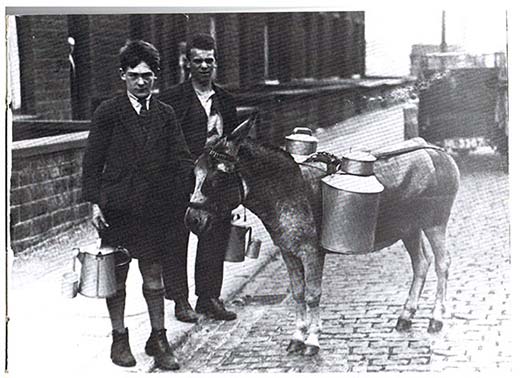Local History Society Report
The history of farming in the industrial Pennines
Speaker:Dr Stephen Caunce
Thursday, 21 February 2019
Does it seem like a contradiction to speak on the topic of 'farming in the industrial Pennines'? That was the question put to members of the audience at a meeting of the Hebden Bridge Local History Society by Dr Stephen Caunce, formerly senior lecturer in history with the University of Central Lancashire. His background as an academic historian has always been partnered by an interest in finding other voices, and in working with museums to bring those experiences to life.
He reminded his audience that in this part of the industrial Pennines the town belongs to the surrounding countryside, and pointed to the thriving agricultural shows in Todmorden and Halifax as evidence of the continued importance of agriculture in the Calder Valley.

Milk being delivered from the church in Golcar in 1928
The geology of the area was significant in the kind of agriculture that developed – the steep dark valleys gave rise to scattered settlements on the more fertile shelves on the hillsides. These were not villages, but clusters of houses within shouting distance, making use of pockets of good soil. The small farms relied on family labour and combined agriculture with textiles.
Stephen pointed to the 1555 Act of Parliament (the Halifax Act) which acknowledged the exceptional position of the people of Halifax whose farming was on such poor ground that they relied on small scale cloth production. He described how the thinly populated uplands were also used productively, with animals taken to graze on the moorlands in summer, and the temporary summer settlements eventually being made permanent.
Even when cloth making was their main source of income and clothiers became very wealthy, industry was still combined with agriculture.
Stephen looked at Red House in Gomersal, built and extended by a wealthy cloth manufacturer, but keeping its fields and links with farming. Inventories of house contents made in the seventeenth century also showed textile and farming equipment side by side. In the nineteenth centuries new farms were still being built, especially those of the laith house type which combined modest living quarters with the laith - housing for the animals and a barn where grain could be threshed and stored. Farming remained a family occupation, with little use of paid labour except at busy times like harvest, when handloom weavers might be employed. The closeness of the growing industrial towns provided a market for produce, especially milk, which would be taken house to house and sold fresh from the farm.
Although the ground was not well suited for sheep, the development of a local breed – the Lonk sheep – which is a low maintenance animal, is evidence of adaptability. There was also the phenomenon of the so-called 'flying herd' where farmers, instead of raising cattle, bought cows which were ready for milking and sold them on when they were no longer of use. Stephen felt that agriculture had survived because of the willingness of farmers to adapt. History had always seen farmers combine other economic activity with their chosen way of life, and he saw this reflected in the diversification and experimentation of the present day. The 'yeoman' spirit of determined independence lives on.
The next meeting of the Hebden Bridge Local History Society, on Wednesday 27th February, will hear from Hywel Lewis who is looking at the woodlands of the south Pennines. All welcome at Hebden Bridge Methodist Church, at 7. 30.
With thanks to Sheila Graham for this report
Details of all the Society’s activities can be found on the website and you can also follow them on their Facebook page.
See also
The first few episodes of Gentleman Jack (screenplay: Sally Wainwright) were inspired by two books written by local historian Jill Liddington, including Nature's Domain published by Pennine Pens


